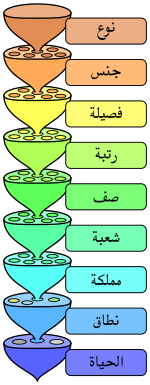مملكة (تصنيف)
المملكة مرتبة تصنيفية في علم تصنيف الأحياء أدنى من النطاق و أعلى من الشعبة و تنضوي تحتها مرتبتان فرعيتان هما :
. . . . . . . . . . . . . . . . . . . . . . . . . . . . . . . . . . . . . . . . . . . . . . . . . . . . . . . . . . . . . . . . . . . . . . . . . . . . . . . . . . . . . . . . . . . . . . . . . . . . . . . . . . . . . . . . . . . . . . . . . . . . . . . . . . . . . . . . . . . . . . . . . . . . . . . . . . . . . . . . . . . . . . . .
الممالك
عددها ست في التصنيف الأمريكي و هنّ :
و يدمج التصنيف البريطاني مملكتي البكتيريا و الأصليات في مملكة واحدة هي البدائيات
المفاهيم المبكرة
المقترحات الأخيرة
ملخص
ملخص لمختلف الأنواع من نظم التصنيفات المقترحة المذكورة في هذا المقال ملخصة في الجدول التالي.
| لينايوس 1735[1] |
هيكل 1866[2] |
شاتون 1925[3][4] |
كوپلاند 1938[5][6] |
ويتيكر 1969[7] |
ووز ورفاقه 1977[8][9] |
ووز ورفاقه 1990[10] |
كڤالير-سميث 1993[11][12][13] |
كڤالير-سميث 1998[14][15][16] |
|---|---|---|---|---|---|---|---|---|
| 2 مملكتين | 3 ممالك | 2 امبراطوريتين | 4 ممالك | 5 ممالك | 6 ممالك | 3 نطاقات | 8 ممالك | 6 ممالك |
| (غير معالَج) | أولانيات | كاذبات النوى | بدائيات | بدائيات | جراثيم حقيقية | بكتريا | جراثيم حقيقية | بكتريا |
| العتائق الأصلية | عتائق | العتائق الأصلية | ||||||
| حقيقيات النوي | Protoctista | أولانيات | أولانيات | حقيقيات النوي | Archezoa | أوليات | ||
| أوليات | ||||||||
| Chromista | Chromista | |||||||
| Vegetabilia | النبات | النبات | النبات | النبات | النبات | النبات | ||
| فطريات | فطريات | فطريات | فطريات | |||||
| الحيوان | الحيوان | الحيوان | الحيوان | الحيوان | الحيوان | الحيوان |
تصنيف الحياة على مستوى المملكة مازال مستخدماً على نطاق واسع كوسيلة مفيدة لتجميع العضيات.[citation needed]
- There is no current consensus on how many kingdoms are present in the Eukarya. In 2009, Andrew Roger and Alastair Simpson emphasized the need for diligence in analyzing new discoveries: "With the current pace of change in our understanding of the eukaryote tree of life, we should proceed with caution."[17]
انظر أيضا
المصادر
- ^ Linnaeus, C. (1735). Systemae Naturae, sive regna tria naturae, systematics proposita per classes, ordines, genera & species.
- ^ Haeckel, E. (1866). Generelle Morphologie der Organismen. Reimer, Berlin.
- ^ Chatton, É. (1925). "Pansporella perplexa. Réflexions sur la biologie et la phylogénie des protozoaires". Annales des Sciences Naturelles - Zoologie et Biologie Animale. 10-VII: 1–84.
- ^ Chatton, É. (1937). Titres et Travaux Scientifiques (1906–1937). Sette, Sottano, Italy.
- ^ Copeland, H. (1938). "The kingdoms of organisms". Quarterly Review of Biology. 13: 383–420. doi:10.1086/394568.
- ^ Copeland, H. F. (1956). The Classification of Lower Organisms. Palo Alto: Pacific Books. doi:10.5962/bhl.title.4474.
- ^ Whittaker, R. H. (January 1969). "New concepts of kingdoms of organisms". Science. 163 (3863): 150–60. Bibcode:1969Sci...163..150W. doi:10.1126/science.163.3863.150. PMID 5762760.
- ^ Woese, C. R.; Balch, W. E.; Magrum, L. J.; Fox, G. E.; Wolfe, R. S. (August 1977). "An ancient divergence among the bacteria". Journal of Molecular Evolution. 9 (4): 305–311. doi:10.1007/BF01796092. PMID 408502.
- ^ Woese, C. R.; Fox, G. E. (November 1977). "Phylogenetic structure of the prokaryotic domain: the primary kingdoms". Proceedings of the National Academy of Sciences of the United States of America. 74 (11): 5088–90. Bibcode:1977PNAS...74.5088W. doi:10.1073/pnas.74.11.5088. PMC 432104. PMID 270744.
- ^ Woese, C.; Kandler, O.; Wheelis, M. (1990). "Towards a natural system of organisms: proposal for the domains Archaea, Bacteria, and Eucarya". Proceedings of the National Academy of Sciences of the United States of America. 87 (12): 4576–9. Bibcode:1990PNAS...87.4576W. doi:10.1073/pnas.87.12.4576. PMC 54159. PMID 2112744.
- ^ PMID 7337818 (PubMed)
Citation will be completed automatically in a few minutes. Jump the queue or expand by hand - ^ PMID 1302186 (PubMed)
Citation will be completed automatically in a few minutes. Jump the queue or expand by hand - ^ PMID 8302218 (PubMed)
Citation will be completed automatically in a few minutes. Jump the queue or expand by hand - ^ Cavalier-Smith, T. (1998), "A revised six-kingdom system of life", Biological Reviews 73 (03): 203–66, doi:, PMID 9809012, http://journals.cambridge.org/action/displayAbstract?fromPage=online&aid=685
- ^ Cavalier-Smith, T. (2004), "Only six kingdoms of life", Proceedings of the Royal Society of London B Biological Sciences 271: 1251–62, doi:, PMID 15306349, PMC: 1691724, http://www.cladocera.de/protozoa/cavalier-smith_2004_prs.pdf, retrieved on 2010-04-29
- ^ Cavalier-Smith T (June 2010). "Kingdoms Protozoa and Chromista and the eozoan root of the eukaryotic tree". Biol. Lett. 6 (3): 342–5. doi:10.1098/rsbl.2009.0948. PMC 2880060. PMID 20031978.
- ^ Roger, A.J. & Simpson, A.G.B. (2009), "Evolution: Revisiting the Root of the Eukaryote Tree", Current Biology 19 (4): R165–7, doi:, PMID 19243692
